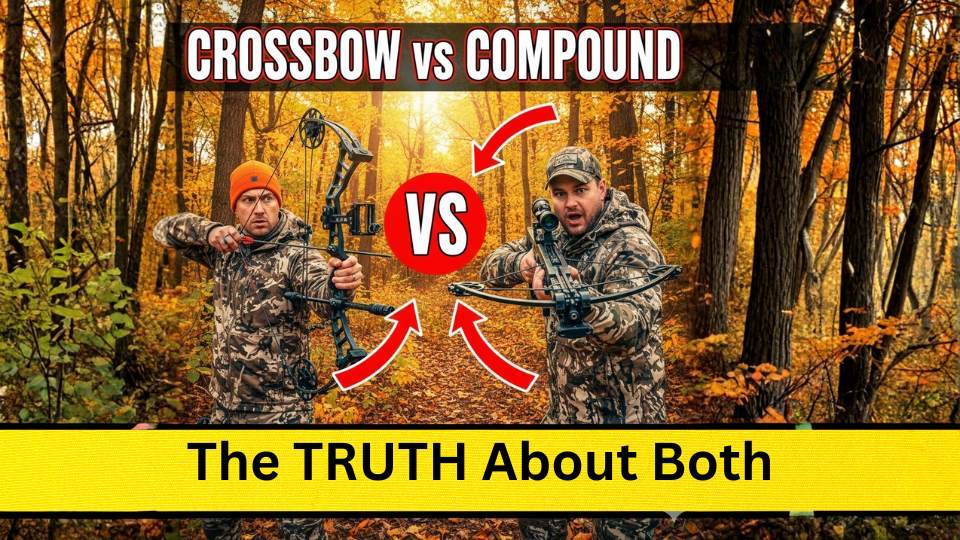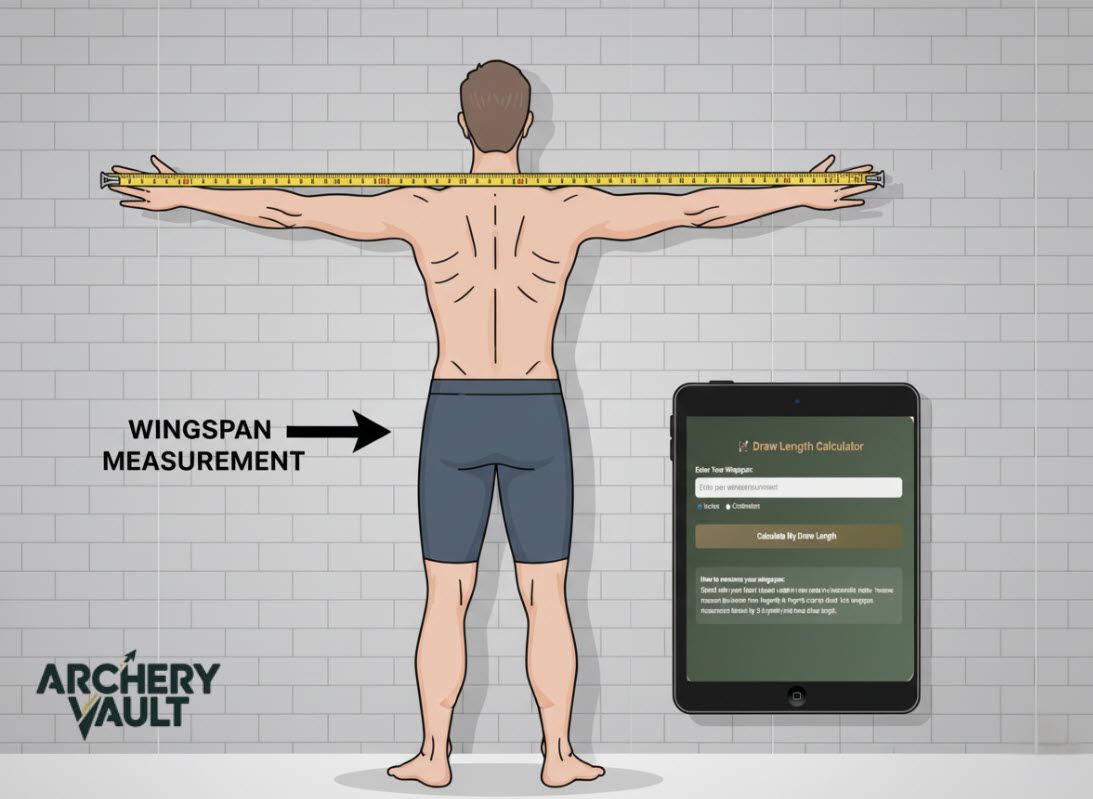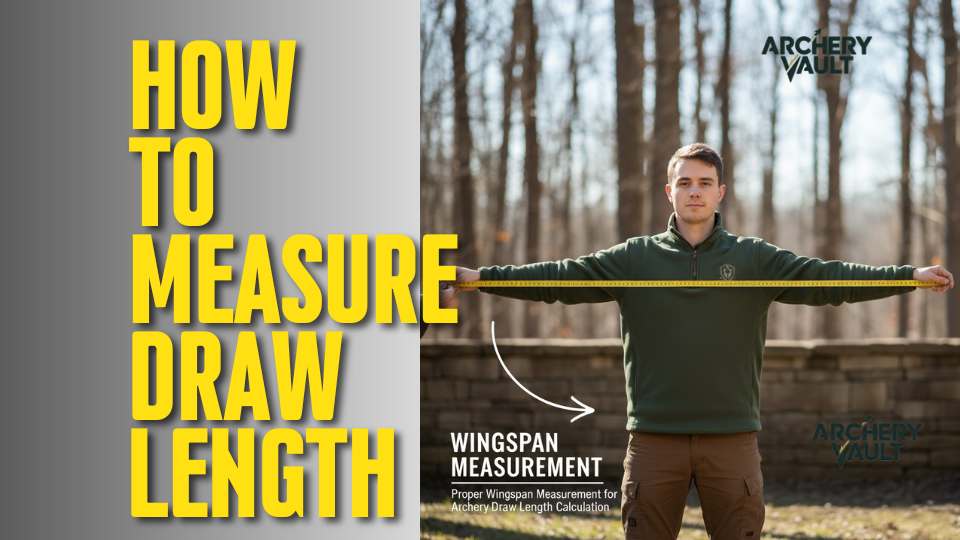The crossbow versus compound bow debate gets heated fast in the hunting community. Compound shooters think crossbows are cheating. Crossbow hunters think vertical bow guys are gatekeeping. The truth? Both work for hunting, but they’re completely different tools that suit different hunters and hunting situations.
This isn’t about which is “better.” It’s about understanding the real differences in accuracy, power, ease of use, legal restrictions, and cost so you can pick the right one for how you actually hunt.
Physical Differences: Crossbow vs Compound Bow
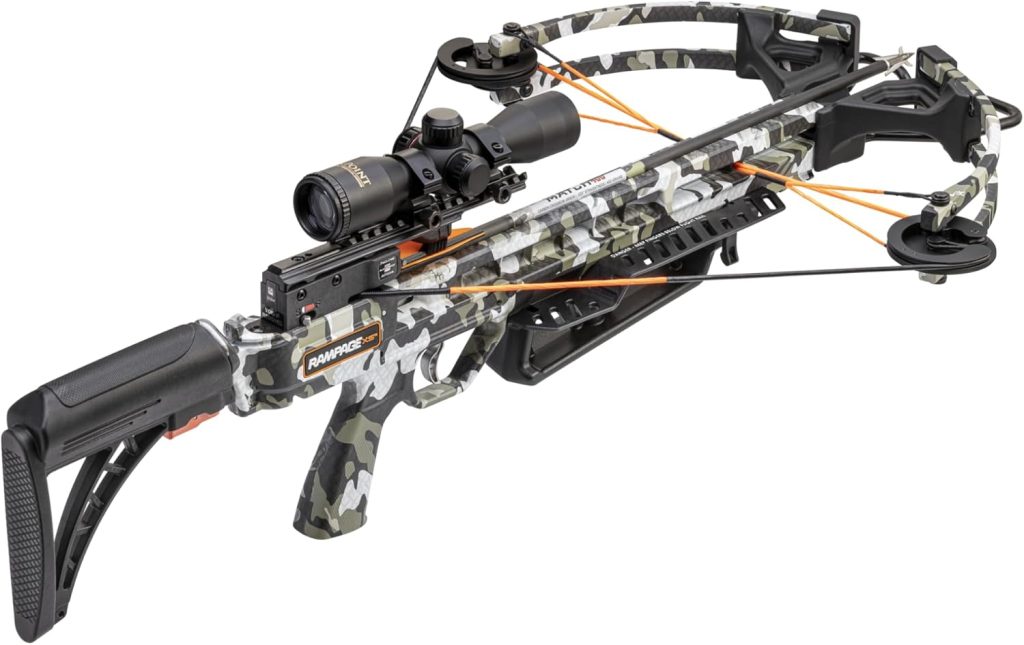
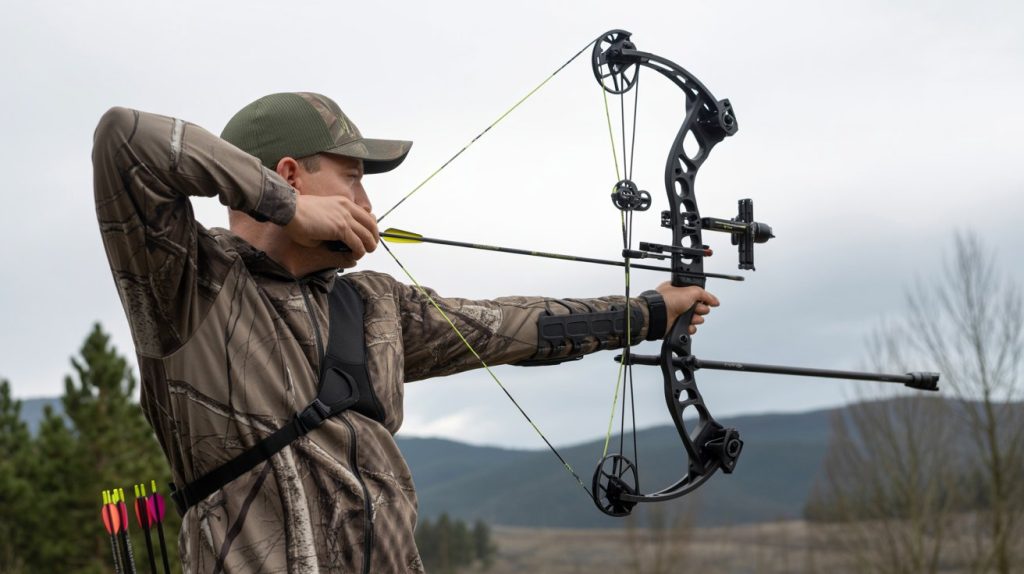
A compound bow is a vertical bow you draw and hold at full draw while aiming. Modern compounds use cams and cables to create let-off (usually 70-80%), so you’re only holding 15-20 pounds at full draw even on a 70-pound bow. You nock an arrow, draw with your back muscles, anchor to your face, aim, and release all in one fluid motion.
Crossbows are horizontal bows mounted on a stock like a rifle. You cock the string back (either manually with a rope cocker or mechanically with a crank), load a bolt into the flight rail, aim through a scope, and pull a trigger. The mechanism holds the string at full draw for you – no strength required once it’s cocked. You’re basically shooting a gun that slings arrows.
That fundamental difference – holding draw weight vs having the bow hold it for you – changes everything about how these tools perform and who they work best for.
Draw Weight and Power: The Numbers Game
Compound bows typically run 50-70 pounds of draw weight for hunting. A 60-pound compound with 80% let-off means you’re holding 12 pounds at full draw. That’s manageable for most adults with proper form and some practice. The arrow launches at 280-330 fps depending on arrow weight and bow specs.
Modern crossbows start around 130 pounds of draw weight and go up to 200+ pounds on high-end models. A Ravin brand crossbow might pull 200 pounds, but you’re not pulling that – the cocking mechanism does it for you. Those heavy draw weights launch bolts at 350-450 fps, sometimes more on top-end models.
Higher draw weight and faster speeds mean more kinetic energy hitting the target. Crossbows typically deliver 100-150 ft-lbs of KE compared to 60-80 ft-lbs from compounds. That extra power translates to better penetration on big game and more margin for error on shot placement. But it also means crossbows are heavier to carry and louder when shot.
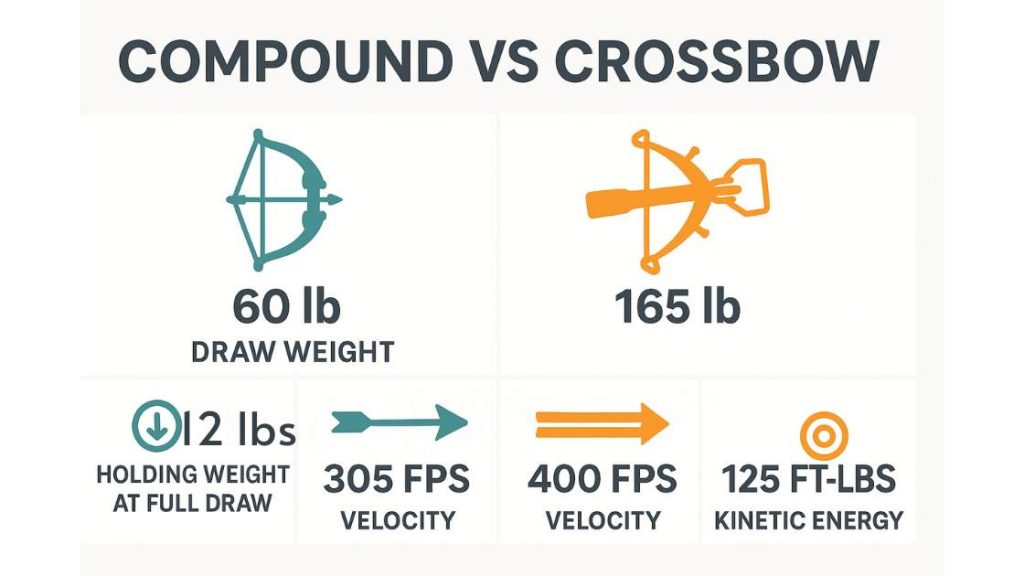
Speed Comparison: FPS Numbers
Crossbows win the speed contest. A decent hunting crossbow shoots 350-400 fps. High-end models hit 450+ fps. Compare that to compound bows running 280-330 fps with hunting arrows. That 100+ fps difference matters for trajectory and effective range.
Faster projectiles drop less over distance. At 50 yards, the difference between 300 fps and 400 fps is significant for arrow drop and aiming adjustment. Crossbows shoot flatter, which makes range estimation less critical. Miss your distance call by 5 yards with a compound and you will likely miss high or low. Same mistake with a crossbow is less punishing.
But speed isn’t everything. Compounds are quieter, lighter to carry all day, and legal during archery seasons in most states. Check your arrow speed against different setups – sometimes a well-tuned compound with light arrows can close that fps gap more than you’d think.
Accuracy: Which Shoots More Consistently?
Crossbows are more accurate for most shooters, especially beginners. You’re aiming from a stable shooting position with a scope, the bow holds the string at full draw so there’s no muscle fatigue affecting your shot, and the trigger release is more consistent than finger releases on compounds. Put a crossbow on shooting sticks or a rest and you can make precise shots at 50+ yards with minimal practice.
Compounds require perfect form. Your anchor point, release technique, bow arm position, back tension – everything affects accuracy. Get lazy with your form and your groups open up. But a skilled compound shooter is incredibly accurate. Olympic archers consistently hit targets at 70 meters using compound-style bows.
The real difference is consistency under hunting pressure. When a buck steps out at 30 yards and your heart is pounding, a crossbow’s mechanical advantage helps. You aim, breathe, squeeze the trigger. With a compound bow, you have to draw smoothly, find your anchor, settle your pin, and execute a clean release while your muscles are shaking from adrenaline. That’s harder.
Ease of Use: Learning Curve Reality
Crossbows are easier to shoot accurately right away. If you can aim a rifle and pull a trigger, you can shoot a crossbow. Cock it (manually or with a crank), load a bolt, aim through the scope, squeeze the trigger. Most people are hitting targets consistently within an hour of picking up a crossbow for the first time.
Compound bows take months to shoot well. You’re building back muscles, learning proper draw technique, finding your anchor point, developing a consistent release. Form matters enormously.
Bad form with a compound means inconsistent shots and possible injury. Most new compound shooters need 50-100 hours of practice before they’re consistently accurate at 30 yards.
For hunters with physical limitations – shoulder injuries, limited upper body strength, older age – crossbows make hunting possible when compounds don’t work. You can hunt from a wheelchair with a crossbow. Hard to do that with a vertical bow where you need to draw and hold weight.
The downside? Crossbows are slower for follow-up shots. Cock, load, aim, shoot, then cock again. That reload time matters if you need a quick second shot. Compounds let you grab another arrow and shoot in seconds if your first shot misses.
Hunting Application: When Each Works Best
Crossbows excel in situations where you’re stationary and need maximum accuracy. Ground blinds, tree stands where you’re sitting, any setup where you can rest the crossbow and take a stable shot. The ability to pre-cock and hold the bow loaded means you can sit ready for hours without fatigue. When game appears, you aim and shoot.
Compounds work better for mobile hunting. Spot-and-stalk, still hunting through the woods, situations where you’re covering distance and need to be ready to draw and shoot quickly. A compound weighs less (4-5 pounds vs 7-10 pounds for crossbows), doesn’t need to be cocked ahead of time, and is quieter for close encounters with deer in thick cover.
For bowhunting whitetails from a tree stand, both work fine. Crossbow gives you easier accuracy and longer effective range. Compound gives you quieter shots and the satisfaction of mastering a more challenging weapon. Pick based on your priorities and what’s legal in your state during archery seasons.
Legal Restrictions and Seasons
Many states allow crossbows during regular bow season now, but not all. Some restrict crossbows to firearm season or require special permits for disabled hunters to use crossbows during archery season. Check your specific state regulations before buying either weapon.
Where I hunt, crossbows are legal during bow season but there’s still stigma in the hunting community. Traditional bowhunters think crossbows give unfair advantage and shouldn’t be allowed during archery-only seasons. Crossbow hunters argue they’re just modern tools and compounds have plenty of advantages too compared to recurves.
The debate won’t end anytime soon. What matters for you: know the rules where you hunt, understand the season dates for different weapon types, and pick equipment that’s legal for the seasons you plan to hunt.
Cost Comparison: What You’ll Actually Spend
Entry-level hunting crossbows start around $300-400. Mid-range models run $500-800. High-end crossbows like Ravin and TenPoint brands top models cost $1500-2500+. You also need bolts (more expensive than arrows), broadheads, a cocking device, and a case. Figure $500-600 minimum to get set up properly for hunting.
Compound bows start cheaper. A beginner compound bow package runs $300-400 with everything included. Mid-range bows cost $500-900. High-end flagship bows from Mathews and Hoyt brands hit $1200-1500 for just the bare bow. But arrows are cheaper than bolts, and you can use the same arrows for practice and hunting.
Maintenance costs are similar. Both need strings replaced eventually, tuning adjustments, and occasional part replacements. Crossbows might need rail lube and more frequent string changes due to higher stresses. Compounds need annual tuning and bow press work if you’re swapping cams or doing major adjustments.
Noise and Stealth Considerations
Compounds are significantly quieter than crossbows. A well-tuned compound with stabilizers and string dampeners makes a soft “thwap” sound. Deer might react but often don’t have time to jump the string before the arrow arrives at 30 yards.
Crossbows are louder – they crack when you shoot. The string releases from higher tension (crossbows don’t have let-off), the limbs snap forward violently, and many crossbows have noisy cocking and trigger mechanisms. Deer absolutely hear the shot. At longer distances it doesn’t matter as much, but up close in the woods, that noise can spook game.
- For hunting situations where you’re shooting 40+ yards from a concealed position, crossbow noise is less of an issue.
- For close-range encounters in thick timber where deer are within 20-25 yards, a quieter compound bow gives you better odds of the deer not reacting before the arrow arrives.
Physical Demands and Hunter Fitness
Shooting a compound bow requires upper body strength and good shoulder health. You’re drawing 50-70 pounds repeatedly for practice, holding your bow arm steady, and executing controlled releases. If you have rotator cuff problems, tennis elbow, or limited back strength, compounds can be painful or impossible to shoot.
Crossbows remove most physical demands. Cock the bow (even a rope cocker makes 150+ pounds manageable), load it, shoot. The draw happens before you ever aim. You can shoot crossbows with one arm, from a seated position, or with limited mobility. That accessibility opens hunting to people who couldn’t use compound bows.
But crossbows are heavier to carry. A loaded crossbow with scope weighs 8-12 pounds. Carry that all day hiking through mountains and you’ll feel it. Compounds weigh 4-5 pounds. For mobile hunting where you’re covering miles, that weight difference matters.
Which Should You Choose: Compound Bow or Crossbow?
Choose a crossbow if you want the easiest path to accurate shooting, you hunt primarily from stationary positions, you have physical limitations that make compounds difficult, or you prioritize maximum effective range and power. Crossbows work great for hunters who want rifle-like performance in bow season or who are new to archery and want success quickly.
Choose a compound bow if you want a lighter weapon for mobile hunting, you value stealth and quiet shots, you want to participate in states where crossbows aren’t allowed during archery season, or you appreciate the challenge of mastering a more difficult weapon. Compounds connect you to traditional archery in ways crossbows don’t.
Or here’s a thought – buy both eventually. Use the compound during early archery season when it’s hot and deer patterns are predictable. Switch to the crossbow later in the season when deer are pressured and longer shots are necessary. Different tools for different situations.
Frequently Asked Questions
Can you use a crossbow during bow season?
It depends on your state. Many states now allow crossbows during archery season, but some still restrict them to firearms season or require special permits. States like Ohio, Michigan, and Wisconsin allow crossbows statewide during bow season. States like Oregon and Colorado have more restrictions. Pennsylvania allows crossbows but only during specific seasons. Check your state’s hunting regulations every year because rules change frequently as crossbow acceptance grows in the bowhunting community.
Which is better for beginners – crossbow or compound bow?
Crossbows are easier for beginners to shoot accurately right away. If your goal is killing deer this season and you’ve never shot archery equipment before, get a crossbow. You’ll be shooting consistent groups within a few practice sessions. Compounds take months of practice to shoot well and require developing proper form and back muscles. But if you have time to learn and want the most versatile archery tool, start with a compound bow package that lets you adjust draw weight and length as you improve.
Are crossbows more accurate than compound bows?
For most shooters, yes. Crossbows offer inherent mechanical advantages – you aim from a stable rifle-like stance, the scope provides precise aiming, and the trigger release is more consistent than finger releases. An average shooter will be more accurate with a crossbow at 40+ yards. But a highly skilled compound bow shooter can match or exceed crossbow accuracy at hunting distances. The difference shrinks at close range (under 30 yards) where both are plenty accurate for ethical shots on deer.
How much does a good hunting crossbow cost?
Expect to spend $500-800 for a quality hunting crossbow that will last multiple seasons. Budget models start around $300-400 but often have cheaper components that fail. High-end crossbows run $1500-2500+ for top brands like Ravin or TenPoint with premium features. Don’t forget accessories – you need bolts ($60-120 per six), broadheads, a cocking device ($30-150), and a case. Budget $600-1000 total to get properly set up with everything you need for crossbow hunting.
Which is quieter when hunting – crossbow or compound bow?
Compound bows are significantly quieter. A well-tuned compound makes a soft “thwap” that deer might not even notice at 30+ yards. Crossbows crack loudly when shot due to higher string tension and no let-off. That noise matters most at close range in thick cover where deer can react before the bolt arrives. If stealth is your priority – hunting bedding areas, still-hunting through woods, close encounters – compounds have a major advantage. For longer shots from blinds, crossbow noise is less critical.
Key Takeaways:
- Crossbows shoot faster (350-450 fps) than compound bows (280-330 fps) and deliver more kinetic energy
- Crossbows are easier to shoot accurately but compounds are lighter and quieter for hunting
- Many states now allow crossbows during archery season, but check local regulations before buying
- Expect to spend $500-800+ for quality crossbows vs $300-500+ for beginner compound bow setups
- Crossbows excel in stationary hunting from blinds; compounds work better for mobile hunting
- Physical limitations favor crossbows; hunters wanting traditional bowhunting challenge prefer compounds
- Both are effective hunting tools for deer-sized game within their respective effective ranges
Which one are you leaning toward for your hunting situation?

